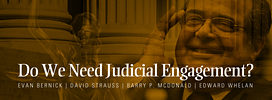Lead Essay
Evan Bernick makes the case for what he terms judicial engagement: If it is true that the federal judiciary serves to safeguard the rights of individuals and the basic structure of the Constitution, then judges will necessarily have to disagree at times with Congress, and those disagreements will necessarily mean that laws are struck down, perhaps often. Independent judgment, and an independent judiciary, requires nothing less. Bernick addresses some progressive and conservative arguments for judicial deference and finds them lacking; he commends an engaged and active judiciary to conservatives who want to protect economic liberties more strongly.
Response Essays
David A. Strauss argues that “judicial engagement” is little more than a buzzword. The political branches of our government can and do fail, but so does the judiciary, and we are not to imagine that somehow a perfected judiciary will one day come along and set everything in its proper place. Like all institutions, the courts have a design and a function that is particularly their own, and this necessarily entails certain institutional features, including institutional failings. Liberals and conservatives alike have watched as the Supreme Court issued rulings that one side or the other did not like. But the problem is not so much whether the Court does too much or too little. Rather, some coherent and defensible judicial philosophy must be found, and when it is, judges should be active, or not, in response to it.
Barry P. McDonald argues that, properly understood, judicial restraint should be praised. In a democracy, unelected judges’ roles are to be narrow, and they must act only with a clear constitutional mandate. When room for reasoned disagreement exists, we already have a method in place to settle it: That method is the ballot box, because legislatures are better than judges at making complex, often discretionary decisions about economic and social policy.
Edward Whelan argues that the real question concerns constitutional originalism, not activism or restraint. What matters is how we answer the question of what the Constitution means, because the answer to this question will (or at least should) determine whether any particular law is allowed or forbidden. Whelan charges that “judicial engagement” means nothing more than libertarian judicial activism, and amounts to an attempt to smuggle in libertarian policy preferences that would otherwise be unacceptable.
Coming Up
Essays by Edward Whelan, Barry P. McDonald, and David A. Strauss discussion and comments through the month.
Related at Cato
Cato Unbound: Judicial Activism and Individual Liberty, February 2014
Cato Supreme Court Review: Archives of the Cato Supreme Court Review.
Event: Constitution Day, featuring a day-long conference at the Cato Institute, September 16, 2016.

